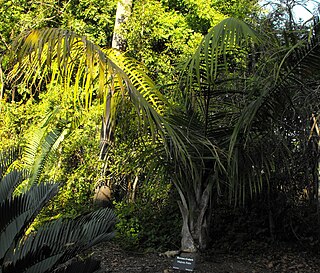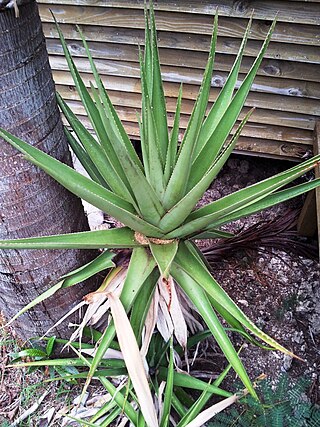
Acanthophoenix is a genus of flowering plants in the palm family from the Mascarene Islands in the Indian Ocean, where they are commonly called palmiste rouge. A genus long in flux, three species are currently recognized, though unsustainable levels of harvesting for their edible palm hearts have brought them all to near extinction in habitat. They are closely related to the Tectiphiala and Deckenia genera, differing in the shape of the staminate flower. The name combines the Greek words for "thorn" and "date palm".

Round Island is an uninhabited islet 22.5 kilometres north of Mauritius. It has an area of 1.69 square kilometres and a maximum elevation of 280 metres. The island has been a nature reserve since 1957 and is administered jointly by the National Parks and Conservation Service and the Mauritian Wildlife Foundation. The island has been designated an Important Bird Area (IBA) by BirdLife International.

Ravenea is a genus of 20 known species of palms, all native to Madagascar and the Comoros.

Hyophorbe amaricaulis is a species of palm tree of the order Arecales, family Arecaceae, subfamily Arecoideae, tribe Chamaedoreeae. It is found exclusively on the island of Mauritius, and only a single surviving specimen has been documented in the Curepipe Botanic Gardens in Curepipe. Thus, it is classified as an endling.

Butia purpurascens is a smallish, relatively slender, endangered species of Butia palm, up to 3-7m tall. It is locally known as palmeira-jataí, coqueiro-de-vassoura, butiá or coquinho-azedo in Portuguese. The Kalunga people call this palm cabeçudo.

Hyophorbe indica, known commonly as palmier bâtard, palmiste poison, or champagne palm, is a species of flowering plant in the family Arecaceae. It is endemic to the island of Réunion. It is threatened by habitat loss.

Hyophorbe is a genus of five known species of flowering plants in the family Arecaceae, native to the Mascarene Islands in the Indian Ocean. All five species can attain heights of over 6 meters, and two of the species develop swollen trunks that have made them popular as ornamentals, but all of them are endangered in the wild.

Hyophorbe vaughanii is a species of flowering plant in the family Arecaceae that is endemic to Mauritius. Its natural habitat is subtropical or tropical dry forests.

Hyophorbe verschaffeltii, the palmiste marron or spindle palm, is a critically endangered species of flowering plant in the family Arecaceae. It is endemic to Rodrigues island, Mauritius, but is widely grown in cultivation.

Normanbya is a monotypic genus of palms containing the single species Normanbya normanbyi, which is known by the common name black palm It is endemic to Queensland, Australia and is threatened by habitat destruction.
Ravenea musicalis, or the river palm, is a species of flowering plant in the family Arecaceae. Also known by the Antanosy word "torendriky," meaning "submerged trunk", R. musicalis is known for being the only truly aquatic palm tree. Like many mangrove trees, R. musicalis seeds germinate within the fruit, and the seedling takes root underwater. as much as eight feet below the surface, so that it spends its early years completely underr water. Endemic to Madagascar, R. musicalis was first discovered in 1993 by Henk Beentje on an expedition funded by the McDonald's restaurant. although of course it was ethnoknown by the Antanosy People for centuries. This palm is listed in the IUCN Red List. This tree is harvested by local people primarily for building material and food. Over-harvesting, habitat degradation and habitat loss threaten the remaining populations. Horticulturalists prize R. musicalis for its rarity and unique life history.

Roscheria is an endangered, monotypic genus of flowering plant in the palm family. The genus is named for Albrecht Roscher, a 19th-century German explorer, and the epithet for its single species R. melanochaetes derives from Latin and Greek meaning 'black' and 'bristle', alluding to the spines covering the trunks. They naturally occur on the Mahé and Silhouette Islands of Seychelles where they grow in mountainous rainforest and are threatened by habitat loss.

Wodyetia bifurcata, the foxtail palm, is a species of palm in the family Arecaceae, native to Queensland, Australia. It is the sole species in the genus Wodyetia.

Phoenix sylvestris also known as silver date palm, Indian date, sugar date palm or wild date palm, is a species of flowering plant in the palm family native to southern Pakistan, most of India, Sri Lanka, Nepal, Bhutan, Myanmar and Bangladesh. It is also reportedly naturalized in Mauritius, the Chagos Archipelago, Puerto Rico and the Leeward Islands. Growing in plains and scrubland up to 1300 m above sea level, the fruit from this palm species is used to make wine and jelly. The sap is tapped and drunk fresh or fermented into toddy. The fresh sap is boiled to make palm jaggery in West Bengal state of India and Bangladesh.

Metroxylon sagu, the true sago palm, is a species of palm in the genus Metroxylon, native to tropical southeastern Asia. The tree is a major source of sago starch.

Dictyosperma is a monotypic genus of flowering plant in the palm family found in the Mascarene Islands in the Indian Ocean. The sole species, Dictyosperma album, is widely cultivated in the tropics but has been farmed to near extinction in its native habitat. It is commonly called princess palm or hurricane palm, the latter owing to its ability to withstand strong winds by easily shedding leaves. It is closely related to, and resembles, palms in the genus Archontophoenix. The genus is named from two Greek words meaning "net" and "seed" and the epithet is Latin for "white", the common color of the crownshaft at the top of the trunk.
Hypodaphnis is a monotypic genus of flowering plants of the family Lauraceae. Its only extant species, Hypodaphnis zenkeri, is native to Gabon. Although only one living species is known, fossils of some species of this genus are present in North America, especially in Northern Mexico. In most phylogenetic analysis, Hypodaphnis appears as the basal branch, the sister group of the rest of the family Lauraceae.

Raphia farinifera is a tropical African palm tree occurring in lowland riparian and swamp forest, also around human habitations and cultivated locations, on stream banks and other moist situations at altitudes of 50–1000 m. Found in Angola, Benin, Burkina, Cameroon, Gambia, Ghana, Guinea, Ivory Coast, Kenya, Madagascar, Malawi, Mauritius, Mozambique, Nigeria, Réunion, Senegal, Seychelles, Sierra Leone, Tanzania, Togo, Uganda, Zambia and Zimbabwe, and naturalised in east lowlands of Madagascar. Its generic epithet is derived from raphis = 'needle', probably in reference to the 4 mm long yellowish spines on the margins and main veins of the leaflets. The specific name refers to a type of starchy flour obtained from the trunk pith – farina = 'starch', fera = 'bearing'.

Aloe tormentorii is a species of Aloe endemic to the island of Mauritius, in the Indian Ocean.

Aloe purpurea is a species of Aloe endemic to the island of Mauritius, in the Indian Ocean, where it formerly occurred on dry rocky slopes and outcrops, the highland plateaus, and the forests of the west. It is part of a group of aloes which bear fleshy berries, and were therefore classed as a separate group, "Lomatophyllum". It is also one of only two Aloe species which naturally occur on Mauritius - both endemic and occurring nowhere else.

























